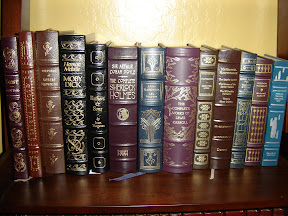Is it this?
 |

In some communities, you can ask the question, when was the last time you visited your public library. The reply can sometimes be, "There is a public library in town?" I remember when I first interviewed for a job at my library, I didn't know where the public library was. That is still one of the things that I don't like about my library, its location. A library should be located off the main street so it can be seen driving by. In addition, the library is the old city hall building so it doesn't look like a library.
Often, the perception of public libraries are that they are a throwback to the 1950s. You can insert the obvious antiquated references here (you know the glasses, the hair in a bun, shushing, dusty old books). It seems that many people have not entered into a library in quite some time. The obvious perception of libraries are the first two pictures. However, you want the perception to be the third picture. People at the library enjoying everything the library has to offer. It is not just about books, or computers, it is about a sense of place. It is somewhere to take your family to get an education, entertainment, and a great experience.
The younger generation that never has entered a library are stuck with stereotypes from the media. They will see more saturation from television and the internet's perceptions of libraries, than from actual libraries. In order to combat this, you need to take an active approach in getting attention for your library.
When I first started working at my library, we had no programming and some technology classes (in which attendance was dismal). Circulation wasn't bad, but it seemed that most of the community did not know where the library was. After doing some research, I realized, there was no way we were telling the public about us. No articles in the newspaper, no press releases, no calendar of events, nothing.
I began to write press releases for the local newspaper. It began to get some attention, but the articles were placed irregularly and usually not in enough time for people to be aware of the program. Most of the attendance for programs (if anyone showed up) was between zero and seven people. It was hard to continue with such low attendance. It wasn't until I had a big series of programs in February, did things begin to take off.
The library was conducting a focus group on the direction of the library. It was mostly a defensive maneuver to ward of cuts to the library budget. (It was post-9/11 everyone was getting cut.) I had a series of cultural events I was planning for February. Most of them came from the Arizona Humanities Council. I hoped to get all of the events together at the beginning of the month in a big spread. The paper did one better by getting images to put in the paper of the performers, a full page spread, and well ahead of time. I ended up getting 45 people for the first program, 30 for the second, and 20 for the third. It was a huge success. So when the focus group was asked if they knew about library programs, they said yes and that they checked their local paper for it.
In this vein, I developed a weekly library news section in the paper. Every Tuesday, we were able to have the paper run the library news for the week. Now people can expect when to get the news and were informed well ahead of time of programs. However, it gets better.
Over time, we began to get reporters from the local paper to cover library news. They came to library board meetings. Some of the first articles they ran were not positive and the information was incorrect or out of context on many occasions. The worst one was when they identified someone else as running the library (grr!). So when the library began its strategic planning process, it was a golden opportunity to change the perception of the library in the newspaper and the local community. I asked the paper to send me a reporter to cover the event and to participate in the process. They sent me the same reporter who made the mistake in the paper (double grr!)
The strategic planning process changed the communities perception of libraries. The reporter wrote a wonderful article about how libraries are not what you thought them to be. That classic, libraries are not about books article, it was great. The community's perception of the library was beginning to change. This is exactly what we wanted.
The best part came just last year. We had been receiving consistent positive coverage from the local paper. However, the lead reporter had never written an article about the library. We received coverage from the valley life reporter and other reporters, but nothing front page, no major article.
In April, I gave the library's annual report to City Council which described our efforts toward fighting adult illiteracy, creating a place for teens, and creating opportunities for workforce development. I was hoping for a big article because we had just started our adult literacy program and were accepting tutors. It was a big step. However, a week went by and no article. I was very disappointed. I had worked so hard, but I still did not get anyone's attention. Then, after a week, the article showed up. It was FRONT PAGE ABOVE THE FOLD! It even had a picture of the chart I provided showing the adult illiteracy rate in the community. We received a dozen calls from the public wanting to be tutors for our program. It was fabulous.
Ever since then, whenever I make a presentation to city council, there is a good chance there will be an article and for that article to be on the front page. If I apply for a grant, request a council action, or described progress on a library issue, it gets great coverage.
Furthermore, since we were receiving such good press, attendance at the library shot up. The April article resulted in twice as many sign-ups for summer reading, circulation, computer use, reference questions, and more are all up double digits. We get coverage in the local paper, the local magazine, and free monthly newspapers throughout town. If there is an event in the library, everyone in town knows about it. Just this week, we had two articles and one photograph of our new bookmobile in the paper. We have market saturation. Oh, and the third picture above, that is a local politician who came to the library for a photo shoot for her campaign advertisement.
Some tips on how to get your marketing started:
1. Find out how people get information.
There is always a source of information. A local newspaper, magazine, radio or television show, and sometimes even word of mouth works. We receive coverage in the paper and magazine. When we did some planning for our Spanish language outreach, we talked to the right people since usage of our Spanish language materials shot up right afterward.
2. Get to know your local media.
Who covers the big stories? Who covers the valley life? Who handles the calendar of events? These are all essential to drum up business for your library.
3. Get to know your local photographers for the local media.
Sometimes a photograph is just as good as a news article. Get your name out there. Call the photographer and ask them to come to your next storytime. Have them take a picture of you with your 20,000 customer of the month. Do something creative, just remember, they don't like talking heads. The shot needs to be framed.
4. Create a calendar of events.
Always have library events or library news. Even if you don't have any events there is something going on in the library that no one may know about. Did you get a new database? Did you get a bunch of new books in? Libraries are happening places, just talk about it.
5. Write press releases.
You always need a snazzy headline. It needs to get the reader's attention. Make sound (music) @ your library, Fight the harsh summer sun @ your library, do something creative. People will most likely go to a good program, but you have to fight the many headlines of other events going on at the same time.
6. Create newsworthy events.
Sometimes a good angle always helps. If you are having a storytime, you can advertise getting your child ready to read at your library. Talk about the increase of people using your computers to apply for jobs.
7. Use your monthly reports.
If you are using a strategic plan, then you probably need to report on its progress each month. This is a time to shine. Show how much the library is being used, demonstrate your impact by how you are accomplishing your goals. Have lots of pictures and charts and use bullet points to make your messages clear and succinct.
8. Find out what stories interest the paper.
If they are pro-library, great, if not, change their perception. There should be a theme that the library likes. Read anything written by the editor and show your library's accomplishments in the same light.
9. Always find an opportunity.
There is always an opportunity for a news story. When our library broke 20,000 circulations in one month, I found out who had the 20,000th circulation, threw some stuff in a bag and presented it as a gift. I called the photographer and they had a small thing in the paper about it. It was a great press opportunity for the library and make the patron's day.
10. Be everywhere.
Usually, you can combine your events with other events in town. You can combine your outreach with your marketing by making your outreach stand out. We plan to paint a mural on our bookmobile so that we are easily identifiable. Whenever we go out, if there is a picture of a general event we are at, you will be able to see us.
Marketing is everything. You can have the greatest program ever and no one will show up if no one knows about it. That is the only way to test the popularity of the program. If everyone knows about it and no one shows up, it is not a popular program. Libraries are fantastic concepts. Free books, free music, free movies, educational and recreational programs, computers with internet access and its all free!

No comments:
Post a Comment